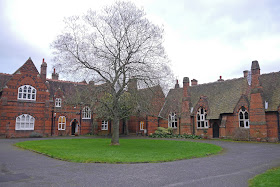Odiham High Street
A late afternoon walk from Odiham. You walk down the High St and follow a path off to the right across a series of damp and muddy fields, emerging on the A287 Farnham Road. I confess I went slightly wrong somewhere and ended up at the wrong point on the A287, but my eye was drawn to this lovely clump of Snowdrops, which had still not opened.
Adjusting for my error, I entered between the gatehouses of Dogmersfield Park and followed a road through woodland.
After a while I reached Dogmersfield Lake, with a beautiful red brick house near the shoreline. Judging by a sign at the park gates, this was Aragon Hall, but I can't find out any more about it.
At this point the walk continued along a narrow track, emerging onto a wider path with stables and other buildings making a picturesque group to the left. To the right, my eye was drawn to these long-horned cattle.
A bit further on, past the long entrance drive to the stables etc, there was a large field containing a great mass of Canada and Greylag geese.
I suddenly noticed however that the two geese in the foreground were separate from the others, which seemed to be trying to avoid their encroachment, and different from them. Swiftly reaching for my telephoto lens, I took this picture and I have since established that they were Chinese Geese, a new species for me.
Now it became possible to see something of Dogmersfield Park (i.e. the house), away over to the right. It is now a hotel, but was once a fine early Georgian house, until badly damaged by fire in 1981 - now presumably rebuilt. I have excluded the ugly modern hotel buildings from this shot - Pevsner describes them as "scandalously bad, barely neo-Georgian".
Soon after this the route turns left, still through parkland, towards the Basingstoke Canal. This is the next bridge, Sandy Hill bridge, dating from about 1792.
The final section of the walk was about 1.5 miles along the bank of this peaceful, but disconcertingly still, canal. It begins to flow from around Odiham.
Conditions: grey, but pleasant enough.
Distance: 5.5 miles.
From: AA - 50 walks in Hampshire.
Map: Explorer 144 (Basingstoke, Alton & Whitchurch).
Rating: three and half stars. A very nice afternoon stroll.

















































